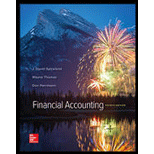
Concept explainers
American Eagle Outfitters, Inc. vs. The Buckle, Inc.
Financial information for American Eagle is presented in Appendix A at the end of the book, and financial information for Buckle is presented in Appendix B at the end of the book.
Required:
1. Calculate American Eagle’s cash return on assets,
2. Calculate Buckle’s cash return on assets, cash flow to sales, and asset turnover ratio.
3. Which company is doing better based on cash return on assets? Which company has the higher cash flow to sales? Which company has the higher asset turnover?
(1)
Cash return on assets:
Cash return on assets if the ration that indicates the profit generated from the operating cash flows over the total assets of the company.
Cash flow to sales:
Cash flow to sales is the ration that indicates the net sales of the company in proportion to the average total assets of the company.
Asset turnover:
Asset turnover is the ration that indicates the net sales of the company in proportion to its average total assets.
To determine: Cash return on assets, cash flow to sales and asset turnover of Company A
Answer to Problem 11.4APCA
a. Cash return on assets =20.0% (2)
b. Cash flow to sales =10.3% (3)
c. Asset turnover (4)
Explanation of Solution
Working note:
1. Calculate the Average total assets:
2. Calculate the cash return on assets:
3. Calculate the cash flow to sales:
4. Calculate the asset turnover:
Note: All dollars in amounts of thousands.
(2)
Cash return on assets:
Cash return on assets if the ration that indicates the profit generated from the operating cash flows over the total assets of the company.
Cash flow to sales:
Cash flow to sales is the ration that indicates the net sales of the company in proportion to the average total assets of the company.
Asset turnover:
Asset turnover is the ration that indicates the net sales of the company in proportion to its average total assets.
To determine: Cash return on assets, cash flow to sales and asset turnover of Company B
Answer to Problem 11.4APCA
a. Cash return on assets =35.9% (2)
b. Cash flow to sales =17.0% (3)
c. Asset turnover (4)
Explanation of Solution
Working note:
1. Calculate the Average total assets:
2. Calculate the cash return on assets:
3. Calculate the cash flow to sales:
4. Calculate the asset turnover:
Note: All dollars in amounts of thousands.
(3)
Cash return on assets:
Cash return on assets if the ration that indicates the profit generated from the operating cash flows over the total assets of the company.
Cash flow to sales:
Cash flow to sales is the ration that indicates the net sales of the company in proportion to the average total assets of the company.
Asset turnover:
Asset turnover is the ration that indicates the net sales of the company in proportion to its average total assets.
To compare: Cash return on asset, Cash flow to sales and asset turnover of Company A and Company B
Answer to Problem 11.4APCA
| Particulars | Company A | Company B |
| Cash return on assets | 20.00% | 35.90% |
| Cash flow to sales | 10.30% | 17.00% |
| Asset turnover | 1.9times | 2.9times |
Table (1)
Explanation of Solution
Company B has higher cash return on assets, Cash flow to sales and asset turnover comparing to the Company A.
Want to see more full solutions like this?
Chapter 11 Solutions
FINANCIAL ACCOUNTINGLL W/CONNECT >IC<
- I need help finding the correct solution to this financial accounting problem with valid methods.arrow_forwardCan you help me solve this general accounting problem with the correct methodology?arrow_forwardI need help with this financial accounting problem using proper accounting guidelines.arrow_forward
- Please provide the solution to this general accounting question using proper accounting principles.arrow_forwardI need help finding the accurate solution to this general accounting problem with valid methods.arrow_forwardWhen incorporating his sole proprietorship, Joe transfers all of its assets and liabilities. Included in the $30,000 of liabilities assumed by the corporation is $500 that relates to a personal expenditure. Under these circumstances, the entire $30,000 will be treated as boot. / Provide explanation please a. True b. Falsearrow_forward
- In determining whether § 357(c) applies, assess whether the liabilities involved exceed the bases of all assets a shareholder transfers to the corporation./ Provide explanation please. a. True b. Falsearrow_forwardI will unhelpful if wrong.arrow_forwardplease don't solve using wrong values i will mark as unhelpful.arrow_forward
- Principles of Accounting Volume 1AccountingISBN:9781947172685Author:OpenStaxPublisher:OpenStax College
 College Accounting, Chapters 1-27AccountingISBN:9781337794756Author:HEINTZ, James A.Publisher:Cengage Learning,
College Accounting, Chapters 1-27AccountingISBN:9781337794756Author:HEINTZ, James A.Publisher:Cengage Learning, Intermediate Accounting: Reporting And AnalysisAccountingISBN:9781337788281Author:James M. Wahlen, Jefferson P. Jones, Donald PagachPublisher:Cengage Learning
Intermediate Accounting: Reporting And AnalysisAccountingISBN:9781337788281Author:James M. Wahlen, Jefferson P. Jones, Donald PagachPublisher:Cengage Learning  Cornerstones of Financial AccountingAccountingISBN:9781337690881Author:Jay Rich, Jeff JonesPublisher:Cengage Learning
Cornerstones of Financial AccountingAccountingISBN:9781337690881Author:Jay Rich, Jeff JonesPublisher:Cengage Learning Financial Accounting: The Impact on Decision Make...AccountingISBN:9781305654174Author:Gary A. Porter, Curtis L. NortonPublisher:Cengage Learning
Financial Accounting: The Impact on Decision Make...AccountingISBN:9781305654174Author:Gary A. Porter, Curtis L. NortonPublisher:Cengage Learning





